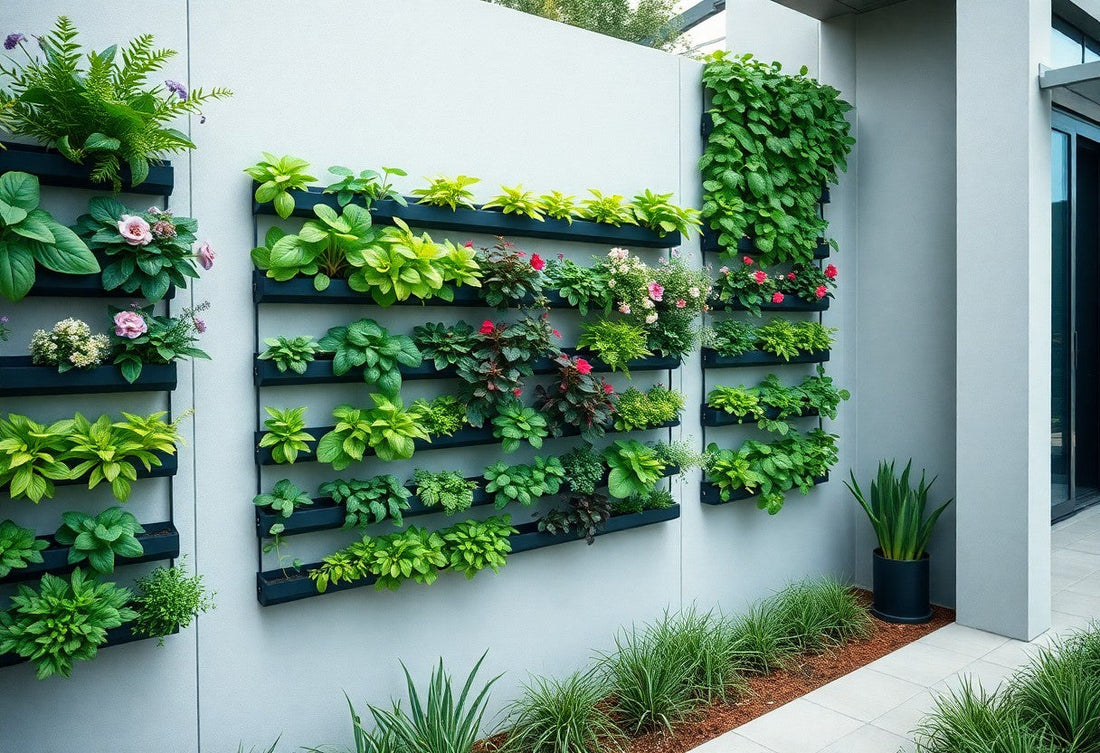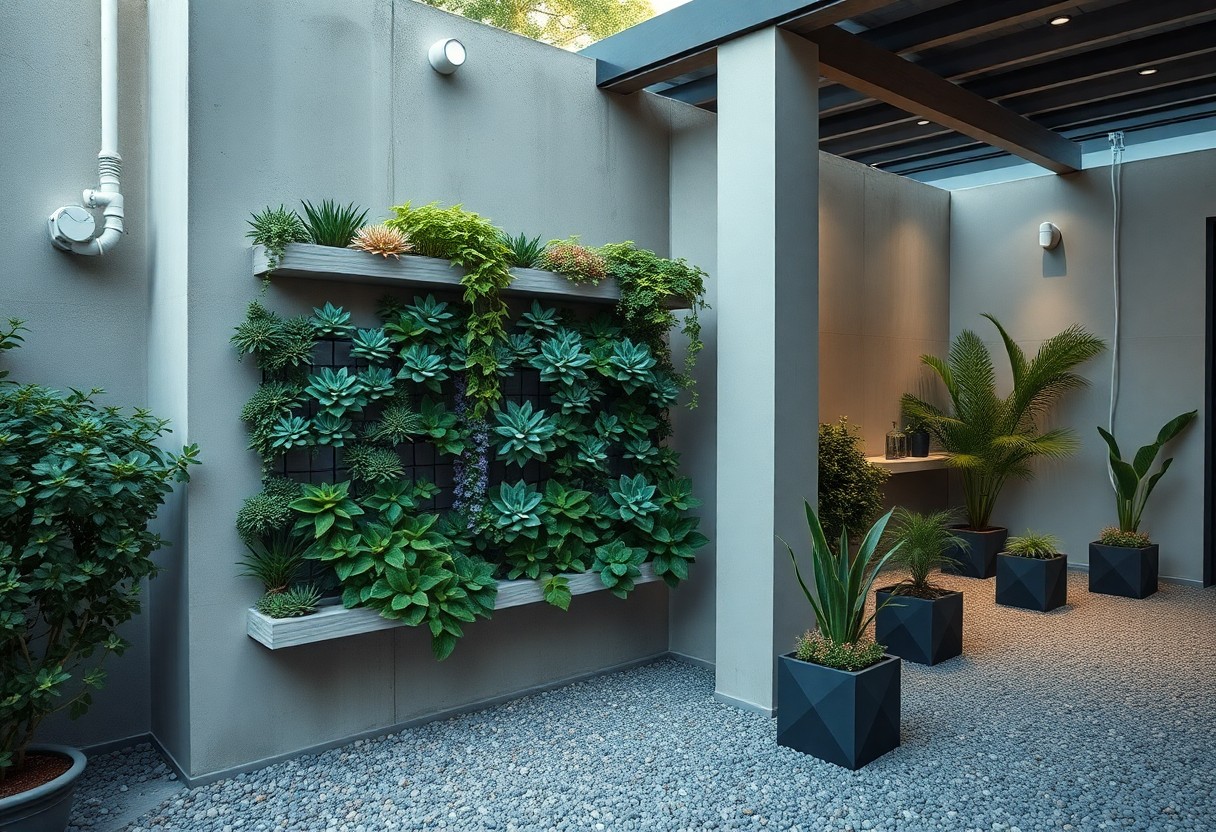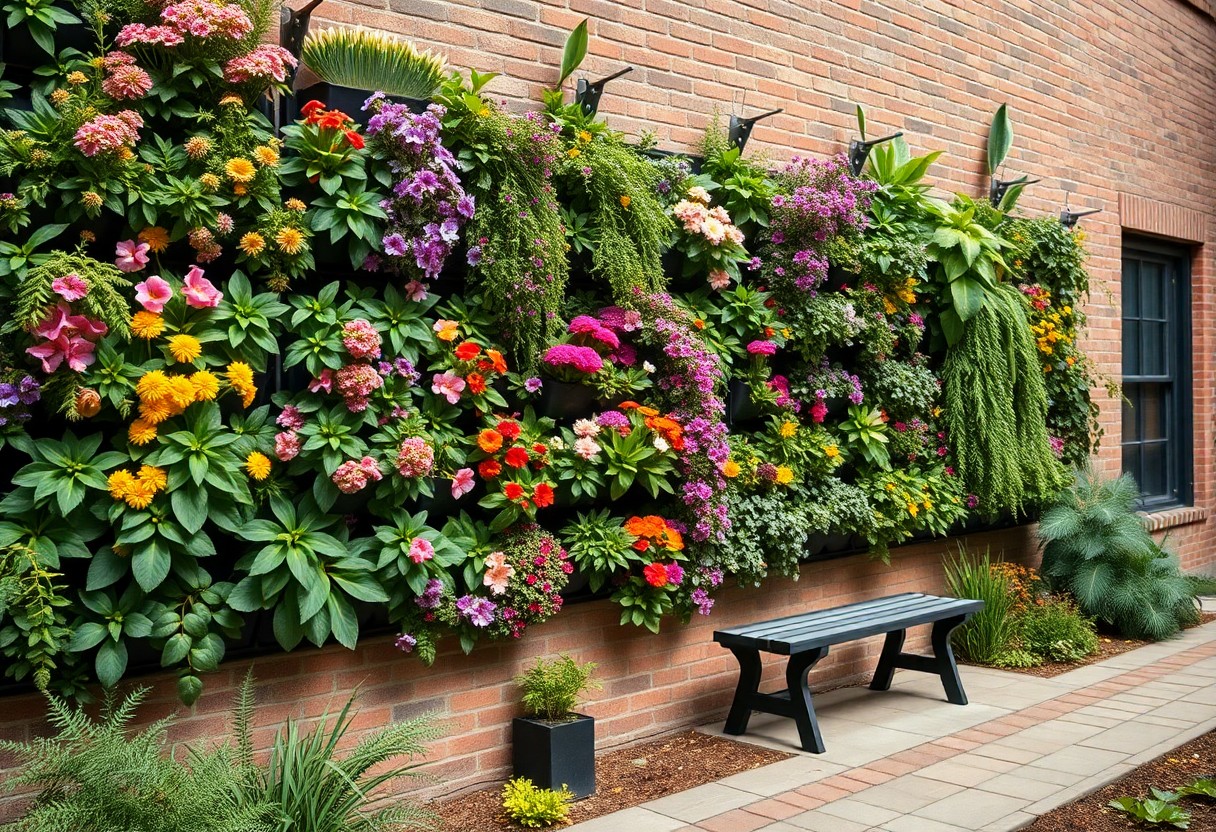
How Do Vertical Garden Systems Maximize Space In Low-Maintenance Outdoor Gardens - Style Meets Sustainability?
Space is often at a premium in your outdoor garden, especially when you prefer low-maintenance options. Vertical garden systems provide an innovative solution by allowing you to grow a variety of plants upward, freeing up valuable ground area for relaxation or other uses. This approach not only enhances the aesthetic appeal of your garden but also supports sustainability by promoting biodiversity and reducing your gardening workload. In this guide, you'll discover how to effectively integrate vertical gardening into your outdoor space, ensuring that style meets sustainability in a seamless and efficient manner.
Transforming Urban Spaces: The Vertical Garden Revolution
The Shift from Traditional Gardening to Vertical Solutions
As urban landscapes become increasingly crowded, the need for efficient gardening techniques has led to a shift from traditional gardening methods to innovative vertical solutions. No longer confined to sprawling farms or spacious backyards, gardens are finding homes on walls, balconies, and even rooftops. This transformation empowers you to cultivate a vibrant array of plants without demanding extensive square footage. Techniques such as hydroponics and modular wall systems make it easy to design your vertical garden with minimal maintenance while delivering impressive aesthetic benefits.
This movement aligns seamlessly with urban living, where time and space are often in short supply. Cities are embracing vertical gardens not only for their beauty but also for their ability to improve air quality and lower urban temperatures. As you choose to incorporate vertical plantings in your outdoor spaces, you become a part of a larger effort to green urban environments, creating pockets of tranquility and biodiversity that serve the community.
Why Vertical Gardens Are Gaining Popularity in Urban Settings
Urban residents are increasingly drawn to vertical gardens for their multifunctional benefits that cater to tight living spaces. You may find the fresh greens, vibrant flowers, and even edible plants seamlessly integrated into a small balcony or narrow alleyway, enhancing your surroundings while maximizing limited real estate. This trend speaks to the desire for self-sufficiency and the growing interest in growing food at home, which continues to inspire new gardeners of all skill levels to think vertically.
Several cities worldwide are adopting vertical gardens as a part of their beautification and sustainability initiatives. For instance, Singapore’s infamous “Gardens by the Bay” showcases towering vertical green walls that not only attract tourists but also play a crucial role in biodiversity and climate response. The growing accessibility of vertical farming technologies contributes to this movement as well—many systems allow you to cultivate your plants without a traditional garden setup. Whether you use dedicated planters, reclaimed materials, or bespoke wall structures, the options are as limitless as your creativity.
Maximizing Limited Real Estate: The Space Efficiency of Vertical Gardens
Understanding Vertical Space Utilization
You can leverage a vertical garden system to make the most of limited outdoor space. These systems allow you to grow vertically, effectively utilizing upwards of 80% more space than traditional gardening methods. By organizing your plants in stacked layers or wall-mounted designs, you not only free up valuable ground area but also create a stunning visual display. Consider using trellises, vertical planters, or even repurposed materials like pallets to showcase your plants. This approach satisfies your aesthetic aspirations while improving the density of your planting areas.
Your plants can thrive in a variety of setups, allowing for diverse arrangements and greater variety. Whether you're cultivating herbs, flowers, or vegetables, vertical gardening opens up new opportunities for creative planting. Above all, it simplifies maintenance: with everything at eye level or within easy reach, you can streamline watering, pruning, and harvesting tasks, making gardening more enjoyable and efficient.
Comparative Analysis: Ground vs. Vertical Gardening
Ground gardening certainly has its benefits, but you might find that vertical gardening presents distinct advantages worth considering. In a flat garden layout, you may struggle with space limitations, particularly in urban environments where every square foot counts. A vertical garden, however, allows you to maximize your planting potential without needing more ground space. Tables summarize specific comparisons that highlight these differences:
Ground vs. Vertical Gardening Comparison
| Aspect | Ground Gardening | Vertical Gardening |
| Space Utilization | Limited to ground area | Utilizes vertical space |
| Accessibility | Requires bending or kneeling | Plants at eye level |
| Water Management | Potential for uneven distribution | Efficient drip irrigation possible |
| Weed Control | Higher likelihood of weeds | Lower incidence of weed growth |
In essence, vertical gardens provide a smart solution for those restricted by their outdoor space. If you have a small patio, balcony, or even just a blank fence, using vertical gardening techniques can increase your yields while minimizing maintenance effort. The advantages extend beyond pure space efficiency; you can also enjoy better airflow and sunlight exposure, reducing the risks of disease and pest issues that commonly plague ground gardeners. Embrace vertical gardening as a way to bring diverse plant life into your space with ease and flair, enhancing both sustainability and style in your outdoor haven.

Designing for Low Maintenance: The Ideal Vertical Garden System
Selecting the Right Plants for Minimal Care
Choosing the appropriate plants is key to ensuring your vertical garden thrives with minimal intervention. Native species tend to require less water and maintenance since they are adapted to your local climate. Think about incorporating drought-resistant varieties such as succulents or herbs like rosemary and thyme that can withstand fluctuations in moisture levels while providing you with culinary delights. Additionally, consider the vertical garden’s specific micro-climate; a sun-loving plant at the top wouldn't fare well alongside shade-tolerant species at the bottom.
For a longer-lasting impact, you can plant perennials that come back year after year. This reduces the need for replanting each season, giving you a consistently vibrant garden without constant upkeep. Grouping plants with similar water and sunlight needs allows you to create an efficient watering schedule, further enhancing the low-maintenance aspect of your garden design.
Innovative Materials and Technologies for Easy Maintenance
Advancements in gardening materials can significantly reduce the workload associated with maintaining your vertical garden. For instance, self-watering systems equipped with reservoirs can help ensure your plants receive a consistent moisture level without daily intervention. These systems often use capillary action to draw water from the bottom, providing just what your plants need without over-saturation. Using lightweight, modular panels made from recycled plastics can also simplify installation and repositioning of your vertical garden, allowing for easy modifications without heavy lifting.
Integrating smart garden technologies offers a modern twist on garden care. Soil moisture sensors connected to smartphone apps can notify you when watering is necessary, taking the guesswork out of plant care. Additionally, some systems incorporate hydroponic techniques that utilize nutrient-rich water rather than soil, which can streamline maintenance and reduce pest issues. This technology encourages faster growth rates while minimizing the risk of diseases typically associated with soil-based gardening.
Aesthetic Appeal: Merging Style with Functionality
Designing Vertical Gardens That Complement Your Outdoor Space
Creating a vertical garden that enhances the beauty of your outdoor area involves considering the existing architecture, landscape, and style of your home. For modern homes, sleek metal frames or geometric planters can provide an architectural appeal, while rustic wooden structures may harmonize beautifully with traditional or country-style settings. Incorporating trellises or wall-mounted planters with climbing plants adds depth and dimension, turning plain walls into striking focal points that naturally attract the eye. Consider your garden's theme—whether it's zen, tropical, or minimalist—to guide your choices and ensure a coherent aesthetic throughout your space.
Proportions and scale play a significant role in design; oversized planters can overwhelm a small area, while petite arrangements might get lost in a spacious garden. Strategically placing vertical gardens at different heights helps create layered landscapes that draw the viewer's gaze both up and down. Incorporating functional elements, such as seating or lighting alongside your vertical gardens, not only creates a more cohesive look but also enhances your outdoor experience, inviting you to spend more time amidst your vibrant living wall.
Exploring Color and Texture in Vertical Plant Arrangements
The choice of plants in your vertical garden is vital for establishing both color dynamics and textural variation. Combining foliage with different hues—such as bright greens, deep purples, and vibrant reds—ensures that your garden remains visually stimulating across seasons. Opt for annuals for bursts of color in spring and summer, while incorporating evergreens for year-round interest. Group plants with diverse leaf shapes and sizes to create an engaging tapestry; low-maintenance options like succulents, ferns, and ornamental grasses provide varied textures that transform a simple vertical space into an enchanting garden display.
Additionally, consider the seasonal changes and maintenance requirements of your selected plants. Interspersing flowering varieties with non-flowering options allows you to create a vibrant yet balanced palette, ensuring something catches the eye regardless of the time of year. Experimenting with vertical structures of different materials—like woven fabric planters or modular systems—offers a unique opportunity to introduce even more texture into your design. By thoughtfully blending color and texture, your vertical garden not only serves a functional purpose but also expresses your personal style and enriches your outdoor oasis.
Sustainable Practices: The Green Benefits of Vertical Gardening
Water Conservation Techniques in Vertical Systems
Vertical gardening systems are designed to optimize water usage, which means you can cultivate a lush garden without the guilt of water wastage. One popular method is drip irrigation, which delivers water directly to the plant roots, ensuring they receive the moisture they need without excessive runoff. Some models even come with built-in reservoirs that capture rainwater, enhancing your garden's sustainability by utilizing natural resources. This system not only conserves water but also reduces your utility bills and minimizes the environmental impact associated with excessive water consumption. Additionally, you can incorporate moisture-retaining materials like coconut coir or hydrogel beads within your vertical garden. These materials help maintain soil moisture levels, allowing for longer intervals between watering. A garden that not only looks vibrant but also operates efficiently helps you cultivate your love for planting while staying eco-conscious.
Utilizing Recycled Materials for Eco-Friendly Gardens
Integrating recycled materials into your vertical garden system is both cost-effective and environmentally advantageous. Many gardeners have successfully repurposed items such as wooden pallets, old crates, or even plastic bottles to create unique planting spaces that breathe new life into discarded materials. This approach not only keeps waste out of landfills but also gives your garden a distinctive character that reflects your personal style and commitment to sustainability. Research indicates that using recycled materials in gardening can lower your carbon footprint significantly. For instance, a vertical garden made from old pallets can offset carbon emissions by providing habitats for local wildlife and reducing the need for newly manufactured garden products. This kind of innovation showcases how you can blend utility and creativity while promoting eco-friendly practices in your gardening endeavors. Utilizing recycled materials often sparks creativity and can lead to unique garden designs that highlight your individual flair. Whether you choose to create hanging planters from tin cans or frame your vertical garden with reclaimed wood, the options are limitless. Each piece tells a story and reinforces your commitment to sustainable practices, inviting others to consider how they, too, can incorporate eco-friendly solutions into their gardening efforts.

The Role of Vertical Gardens in Enhancing Biodiversity
Supporting Pollinators and Local Ecosystems
You have the power to transform your outdoor space into a thriving haven for local wildlife, especially pollinators such as bees, butterflies, and birds. Vertical gardens, often packed with diverse plant species, provide imperative habitats and food sources that support these critical creatures. By choosing a mix of flowering plants with varying bloom times, you can ensure there’s something in bloom throughout the growing season, drawing in more pollinators to your garden. Studies show that gardens with a greater plant diversity can host up to 83% more bee species compared to monoculture setups, making vertical gardens a vital tool in fostering urban biodiversity. Additionally, vertical gardens can serve as stepping stones in fragmented landscapes, linking various green spaces in urban environments. These gardens create ecological networks that encourage pollinators to travel and thrive within your community. Your choice to incorporate vertical structures can significantly impact the local ecosystem, leading to improved pollination rates for not just your garden, but for surrounding flora as well. To learn more about how environmentally conscious design is influencing urban landscapes, check out this resource on How Sustainable Vertical Gardens Are Shaping Architecture.
Community Impact: Sharing Green Solutions Triggers Local Engagement
Engaging your local community through vertical gardening initiatives can amplify the benefits of these systems. When you create a vertical garden, you're not only beautifying your space but also inviting neighbors to explore the principles of sustainability and ecological stewardship. Workshops and community events centered around vertical gardening can facilitate knowledge exchange, encouraging others to adopt low-maintenance, environmentally friendly gardening practices. Moreover, as you share your successes and challenges in maintaining a vertical garden, you may inspire collective action in your neighborhood. This shared experience can foster a sense of belonging and responsibility towards local green spaces. Collaborative projects can also emerge, leading to community gardens that rely on vertical gardening techniques, amplifying the environmental benefits, and further enhancing local biodiversity. Your active participation sets the stage for more environmentally-minded community initiatives, building a greener future together. Through community engagement, you'll not only witness the direct environmental benefits of your vertical garden but also contribute to a more connected, informed, and proactive community. Sharing knowledge and experiences cultivates an environment where sustainable practices thrive, leading to more impactful change at the local level.
Overcoming Challenges: Troubleshooting Common Vertical Garden Issues
Addressing Plant Health and Pests in High Spaces
Your vertical garden can turn into a beautiful, lush oasis, but it may also attract pests and diseases if not monitored closely. Regular inspections of your plants, even in elevated spaces, help pinpoint any potential issues. For example, aphids might congregate on the undersides of leaves, and when you notice them, treating the area with insecticidal soap can eliminate the problem without harming beneficial insects. Similarly, keep an eye out for signs of fungal diseases, identified by yellowing leaves or moldy surfaces. Quick action can save the foliage and ensure it thrives.
Ensuring Adequate Lighting and Irrigation for Success
Your vertical garden's success hinges heavily on its access to light and water. Consider the direction your vertical garden faces; ideally, a south-facing wall captures the most sunlight. If your garden is in a predominantly shaded area, using high-efficiency grow lights can replicate natural sunlight, providing around 12-16 hours of light per day for optimal growth. Observe your plants closely—if they start leaning or stretching towards the light, it’s a strong signal they need more exposure.
Irrigation systems can often be the unsung heroes of vertical gardening. Automated drip irrigation ensures all your plants receive the moisture they need without manual intervention. This is especially effective in vertical systems, where gravity can make it easy for water to run away from the plant's roots instead of nourishing them. Micro-spray emitters or soaker hoses positioned strategically can keep moisture levels consistent, helping you avoid both drought stress and overwatering.
